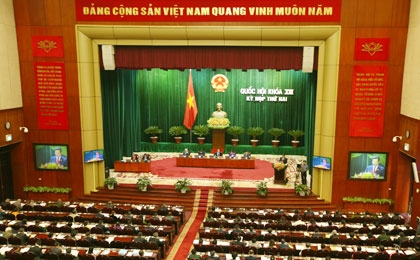National Assembly lays out future challenges
 |
| The 13th National Assembly’s second session opened this morning in Hanoi |
The 46-day session will adopt laws on information security and a resolution on the 13th National Assembly’s law and ordinance building programme.
Besides giving opinions on 13 other laws, the session will hear reports on the 2011-2015 socio-economic development plan, the implementation of socio-economic plans and state budget estimates for 2011. Deputies will also decide on the socio-economic development orientation and state budget estimates and allocations for 2012.
The National Assembly Office chief Nguyen Hanh Phuc said the session was of great importance as it would revise the first year of implementing the 2011-2015 socio-economic development plan, then make targets for the next years. Also, government reports on anti-corruption and anti-waste will also be scrutinised.
The session will also earmark 2.5 days for question-and-answer activities.
Prime Minister Nguyen Tan Dung reported that though Vietnam’s economy continued being hurt by big challenges emerging from the world’s economic difficulties, there were many bright spots.
For example, in this year’s first nine months, the country’s total export and import turnover was estimated to be over $70 billion and $76.87 billion, up 35.4 and 26.9 per cent against last year’s corresponding period.
It is expected that the total export-import turnover will be $95 billion and $105 billion this year, up 31.6 and 23.8 per cent, respectively, against 2010.
However, the country’s average gross domestic product (GDP) is expected to be 6 per cent this year, lower than the National Assembly’s target of 7-7.5 per cent and 2010’s 6.8 per cent. Also, the inflation rate is expected to be 18 per cent this year, far higher than 7 per cent targeted in early this year.
Under a government report delivered at the session, the government’s prime priorities for 2012 will be to curb inflation, stabilise the macroeconomy and keep reasonable economic growth closely pertaining to economic restructure and renewal of growth model in a manner that the economy’s quality, effectiveness and competitiveness will be improved.
Particularly, in 2011 and 2012, bridling inflation and keeping reasonable economic growth are stressed to create firm a foundation for the economy to develop more stably from 2013.
Specifically, the inflation rate is expected to be less than 10 per cent next year and 5-7 per cent by 2015, while the GDP is expected to rise 6-6.5 per cent against 2011, with total export turnover $106.4-107.4 billion, up 12-13.1 per cent against 2011, and total trade deficit $12.4-$12.8 billion.
According to a government report on socio-economic development for 2011-2015, the overall economic target for the 2011-2015 period will be “stable and rapid economic development in association with growth model renewal and economic restructure in a way that economic quality, effectiveness and competitiveness will be improved.”
Recently, the government reported to the National Assembly Standing Committee that 2011-2015 would include two scenarios for economic growth. Under the first scenario, the average five-year economic growth rate will be 6.5 per cent, with gross domestic product (GDP) of nearly $180 billion and per capita GDP of $1,965 against 2010’s $1,168. Total export-import turnover will rise 12 per cent annually and public debt will not exceed 65 per cent of GDP.
Meanwhile, the second scenario forecasts the annual economic growth rate in between 2011-2015 will be 7 per cent, with GDP of $184 billion and per capita GDP of $2,000 against 2010’s $1,168. Total export-import turnover will rise 14 per cent annually and public debt will not exceed 65 per cent of GDP.
Specifically, the government reported that in the 2006-2010, under the Party’s sound leadership, the National Assembly’s frequent supervision, the government’s sturdy efforts, Vietnam’s economic growth rate remained high, social welfare and national security were secured and the country’s regional and global position was enhanced.
In this period, GDP sat at 7 per cent, lower than the National Assembly’s earlier target of 7.5-8 per cent, but higher than other regional nations.
Total export turnover growth rate increased by 17.3 per cent annually, however the trade deficit was 22.4 per cent of total export turnover.
What the stars mean:
★ Poor ★ ★ Promising ★★★ Good ★★★★ Very good ★★★★★ Exceptional
 Tag:
Tag:
Related Contents
Latest News
More News
- Vietnam’s green transition demands collective financial action (December 15, 2025 | 12:00)
- VIR workshop highlights capital and policy for sustainable development (December 15, 2025 | 11:00)
- National Assembly approves pilot mechanisms to accelerate major projects in Hanoi (December 12, 2025 | 11:29)
- Vietnam eases policy approval requirements, simplifies foreign and outbound investments (December 11, 2025 | 17:53)
- Unpacking new momentum in Vietnam’s M&A market (December 10, 2025 | 09:59)
- Forum honours outstanding M&A deals, strategies, and advisory firms (December 09, 2025 | 18:22)
- Vietnam enters defining phase of M&A growth (December 09, 2025 | 17:00)
- Vietnam’s M&A market opens new opportunities amid strong economic momentum (December 09, 2025 | 15:00)
- Vietnam M&A Forum 2025: new position, new momentum (December 09, 2025 | 14:30)
- FDI in Vietnam jumps on additional capital and share purchases (December 09, 2025 | 13:56)
























 Mobile Version
Mobile Version